Multi-Sensor Combined Measurement While Drilling Based on the Improved Adaptive Fading Square Root Unscented Kalman Filter
Abstract
:1. Introduction
2. Multi-Sensor Combination Measurement Based on the IAFSR-UKF
2.1. A nonlinear System Model of MWD Based on Quaternion
2.2. IAFSR-UKF Based Multi-Sensor Combined Measurement
2.2.1. The Description of Square Root Filter
2.2.2. The Description of Adaptive Fading Filter
2.2.3. The Design of IAFSR-UKF
2.2.4. The Improved Calculation Method for Fading Factor
- (1)
- By using Cholesky and QR decomposition, the square root is used instead of the error covariance matrix to participate in the recursive operation. Therefore, the problem that the matrix is easy to fall into negative definite is successfully avoided. Furthermore, the problem of filter divergence is solved and the stability of numerical calculation is also ensured.
- (2)
- According to the theory of the strong tracking filter, a fading factor is introduced to adjust the square root of the filter gain matrix and the output covariance matrix in real-time. When there is a significant error in the equivalent measurement value, the parameter Ct increases, and the corresponding adaptive factor increases, resulting in the increase of the square root of the output covariance matrix, thereby reducing the filter gain, and then reducing the impact of measurement noise on the state update. Therefore, compared with the classical UKF, the proposed algorithm has better model mismatch robustness and excellent strong tracking ability.
- (3)
- In addition, the improved calculation method of the fading factor can effectively reduce the computational complexity while ensuring the filtering accuracy.
3. Performance Evaluation and Discussion
3.1. Laboratory Testing
3.2. Field-Drilling Testing
3.3. Real-Time Evaluation
4. Conclusions
Author Contributions
Funding
Acknowledgments
Conflicts of Interest
References
- Gao, Y.; Wang, Y.L.; Cheng, W.B. Robust adaptive filtering method for dynamic attitude measurement of steering drilling. J. China Iner. Teh. 2016, 24, 437–442. [Google Scholar]
- Cheng, W.B.; Gan, Y.Y.; Cheng, X.R.; Jiang, L.P.; Liu, F. Single quadrant correction of installation error for vertical steering drilling tool. J. China Sci. Ins. 2018, 39, 41–47. [Google Scholar]
- Zhu, X.H.; Hu, Z.Q. Lateral vibration characteristics analysis of a bottom hole assembly based on interaction between bit and rock. J. Vib. Shock. 2014, 33, 90–93. [Google Scholar]
- Xue, Q.L.; Wang, R.H.; Sun, F. Continuous measurement while drilling utilizing strap-down multi model surveying system. IEEE Trans. Instrum. Meas. 2014, 63, 650–657. [Google Scholar]
- Gao, Y.; Cheng, W.B.; Wang, Y.L. Multi-source dynamic attitude combination measurement for near-bit drilling tool. J. China Iner. Teh. 2017, 25, 146–150. [Google Scholar]
- Yang, J.X.; Yang, C.; Jiang, Z.T.; Jiang, J.B. Adaptive extraction of gravity information for drilling tool with magnetic and inertial integrated system. J. China Coal. Soc. 2017, 42, 3331–3337. [Google Scholar]
- Mahmoud, E.; Aboelmagd, N.; Jacques, G.; Umar, I.; Naser, E. Wellbore surveying while drilling based on Kalman filtering. Amer. J. Eng. Appl. Sci. 2010, 3, 240–259. [Google Scholar]
- Mahmoud, E.; Aboelmagd, N.; Naser, E. Continuous wellbore surveying while drilling utilizing MEMS gyroscopes based on Kalman filtering. In Proceedings of the SPE Annual Technical Conference Exhibition, Florence, Italy, 19–22 September 2010; pp. 5416–5428. [Google Scholar]
- Jurkov, A.S.; Cloutier, J.; Pecht, E.; Mintchev, M.P. Experimental feasibility of the in-drilling alignment method for inertial navigation in measurement-while-drilling. IEEE Trans. Instrum. Meas. 2011, 60, 1080–1090. [Google Scholar] [CrossRef]
- Noureldin, A.; Irvine-Halliday, D.; Mintchev, M.P. Accuracy limitations of FOG-based continuous measurement-while-drilling surveying instruments for horizontal wells. IEEE Trans. Instrum. Meas. 2002, 51, 1177–1191. [Google Scholar] [CrossRef]
- Noureldin, A.; Tabler, H.; Irvine-Halliday, D.; Mintchev, M.P. Testing the applicability of fiber optic gyroscopes for azimuth monitoring for measurement-while-drilling processes in the oil industry. In Proceedings of the IEEE Position Location and Navigation Symposium, San Diego, CA, USA, 13–16 March 2000; pp. 291–298. [Google Scholar]
- Pecht, E.; Mintchev, M.P. Observability analysis for INS alignment in horizontal drilling. IEEE Trans. Instrum. Meas. 2007, 56, 1935–1945. [Google Scholar] [CrossRef]
- Zhang, Y.S.; Wang, S.W.; Fang, J.C. Measurement-while-drilling instrument based on predigested inertial measurement unit. IEEE Trans. Instrum. Meas. 2012, 61, 3295–3302. [Google Scholar]
- Chen, C.; Zhang, Y.; Li, C. Surveying method of measurement while drilling based on the inertial sensor. In Proceedings of the 1st International Conference PCSPA, Herbin, China, 17–19 September 2010; pp. 1192–1195. [Google Scholar]
- Xue, Q.L.; Leung, H.; Wang, R.H.; Liu, B.L. Continuous real-time measurement of drilling trajectory with new state-space models of Kalman filter. IEEE Trans. Instrum. Meas. 2016, 65, 144–154. [Google Scholar] [CrossRef]
- Hu, H.D.; Huang, X.L. SINS/CNS/GPS integrated navigation algorithm based on UKF. J. Syst. Eng. Electron. 2010, 21, 102–109. [Google Scholar] [CrossRef] [Green Version]
- Gao, B.B.; Hu, G.G.; Gao, S.S.; Zhong, Y.M.; Gu, C.F. Multi-sensor optimal data fusion based on the adaptive fading unscented Kalman filter. Sensors 2018, 18, 488. [Google Scholar] [CrossRef] [PubMed] [Green Version]
- Hu, G.G.; Gao, S.S.; Zhong, Y.M. A derivative UKF for tightly coupled INS/GPS integrated navigation. ISA Trans. 2015, 56, 135–144. [Google Scholar] [CrossRef]
- Hu, G.G.; Gao, S.S.; Zhong, Y.M.; Gao, B.B. Stochastic stability of the derivative unscented Kalman filter. Chin. Phys. B 2015, 24, 070202. [Google Scholar] [CrossRef]
- Gao, Z.H.; Mu, D.J.; Gao, S.S.; Zhong, Y.M.; Gu, C.F. Adaptive unscented Kalman filter based on maximum posterior and random weighting. Aerosp. Sci. Technol. 2017, 71, 12–24. [Google Scholar] [CrossRef]
- Yang, Q.J.; Xu, B.C.; Zuo, X.; Jiang, H.X. An unscented Kalman filter method for attitude measurement of rotary steerable drilling assembly. Acta Petro. Sinica. 2013, 34, 1168–1175. [Google Scholar]
- Xu, B.C.; Yang, Q.J.; Jiang, H.X. Improved unscented Kalman filtering method for colored noises of rotary steerable system. J. China Uni. Petro. 2015, 39, 157–163. [Google Scholar]
- Cui, X.Y.; Jing, Z.; Luo, M.J.; Guo, Y.; Qiao, H. A new method for state of charge estimation of lithium-lon batteries using square root cubature Kalman filter. Energies 2018, 11, 209. [Google Scholar] [CrossRef] [Green Version]
- Steward, J.L.; Aksoy, A.; Haddad, Z.S. Parallel direct solution of the ensemble square root Kalman filter equations with observation principal components. J. Atmos. Ocean. Tech. 2017, 34, 1867–1884. [Google Scholar]
- Zhang, S.C.; Hu, G.D. Square-root filtering and its applications in target tracking. J. Harbin Ins. Tech. 2008, 40, 700–704. [Google Scholar]
- Yang, Y.; Gao, Y.; Liu, H.L. Research on learning algorithm of neural networks based on improved fading unscented Kalman filter. Cont. Eng. China 2019, 26, 1–7. [Google Scholar]
- Gao, S.S.; Yang, Y.; Gao, B.B. Neural network learning algorithm based on fading Kalman filtering and its application. J. Northwestern Polytech. Uni. 2015, 33, 320–325. [Google Scholar]
- Hu, W.J.; Zhou, D.H. Adaptive control of DC-DC converters based on a strong tracking fllter. J. Tsinghua Uni. (Sci. Technol.) 2008, 48, 1712–1717. [Google Scholar]
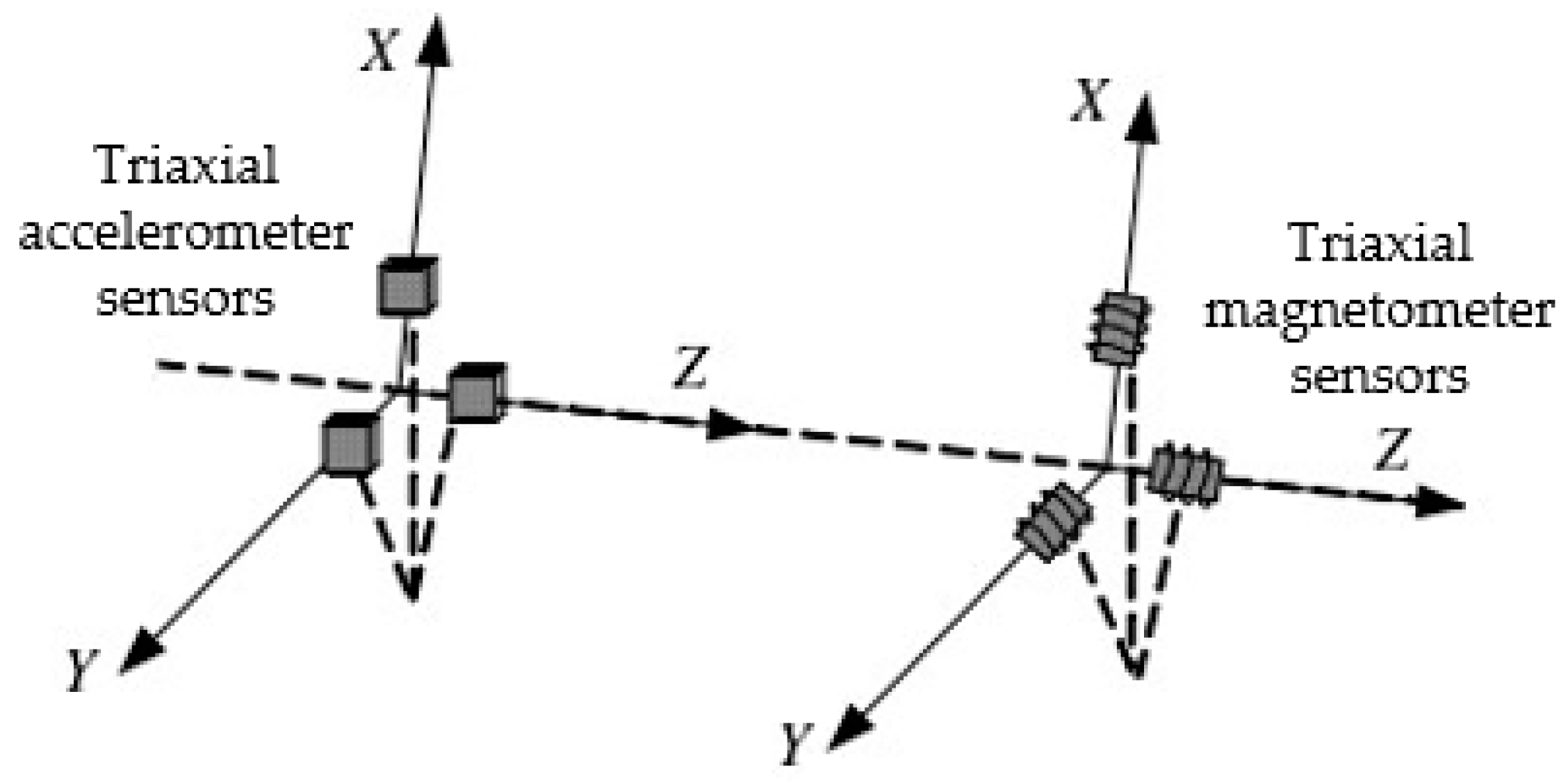


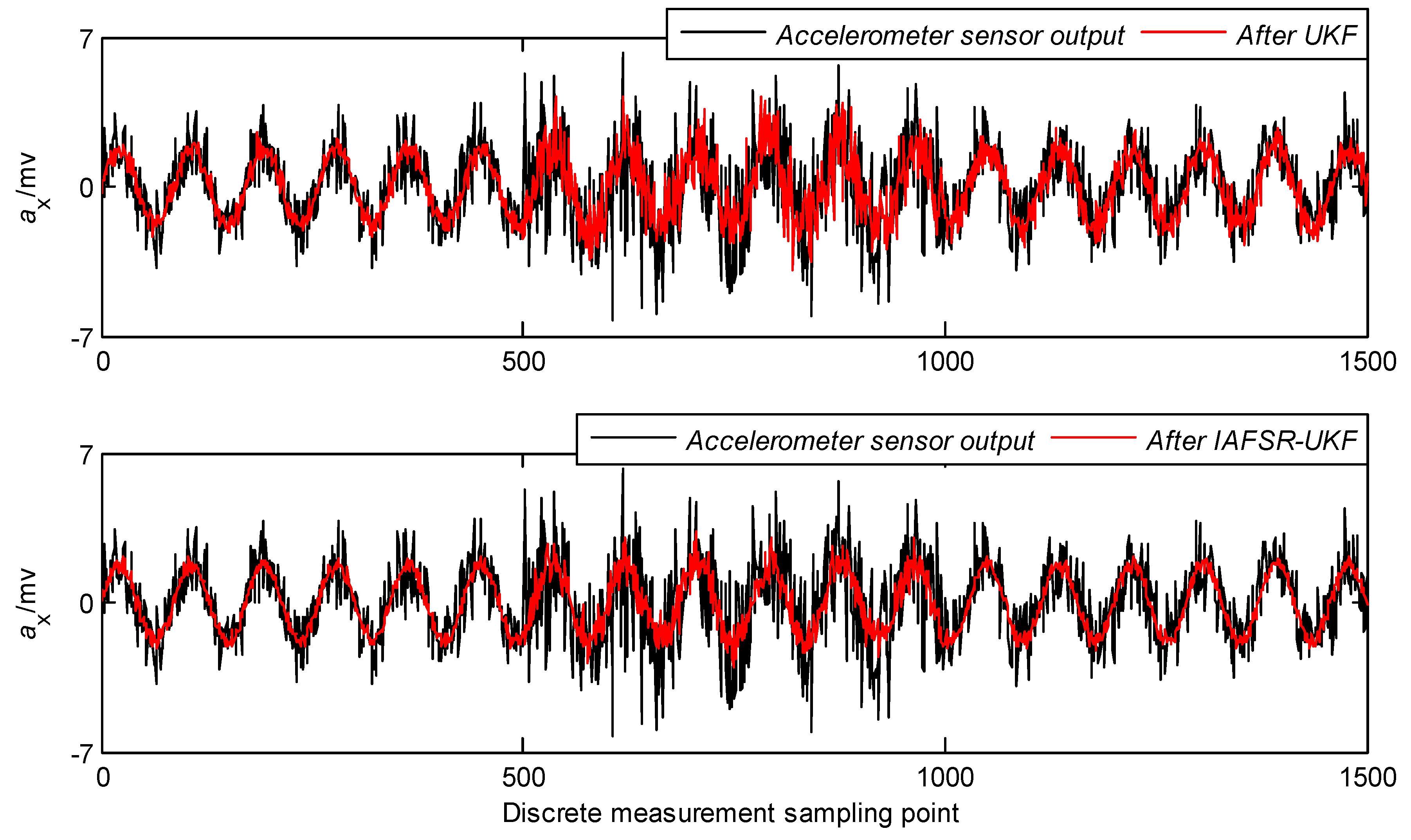

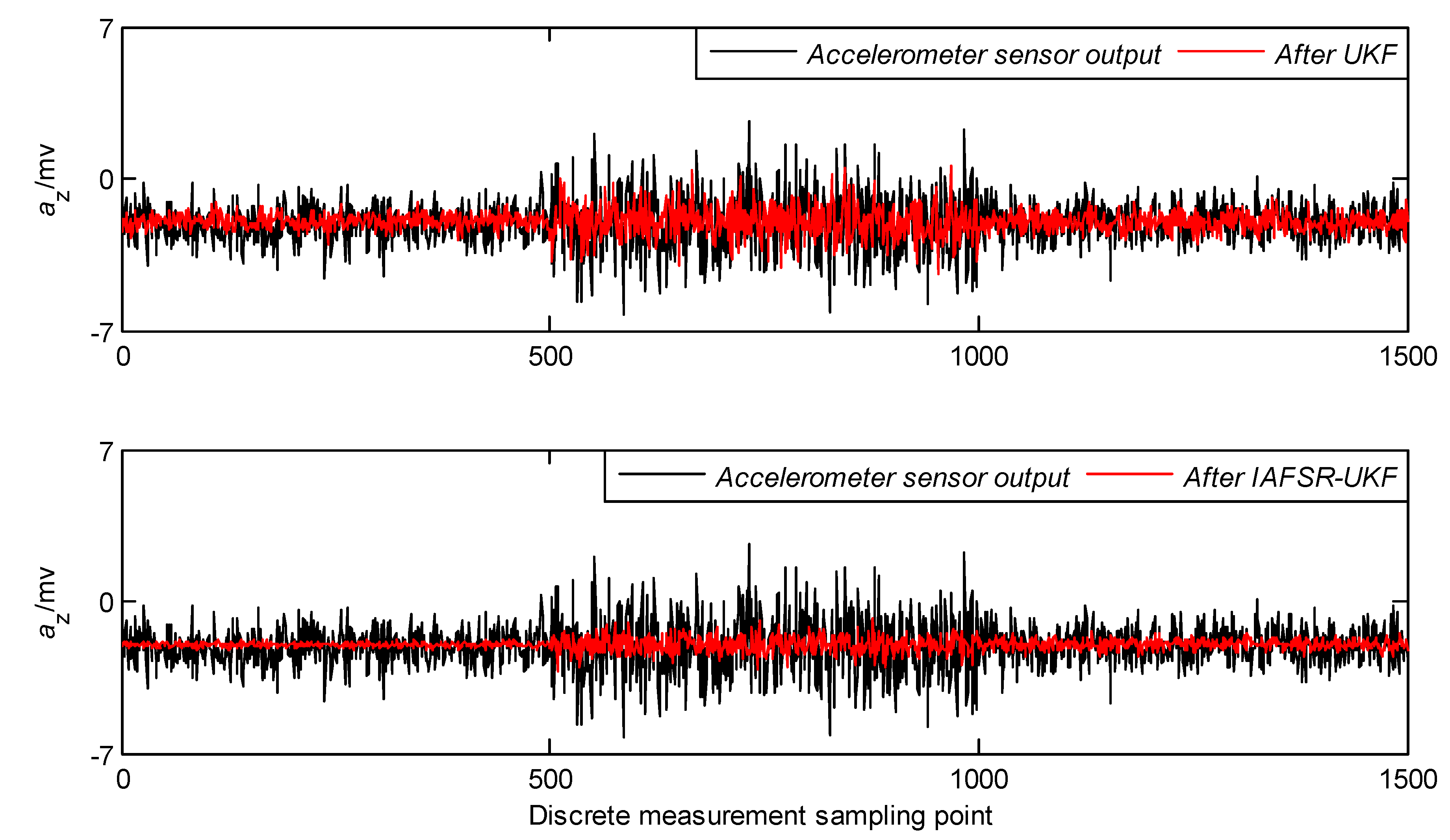
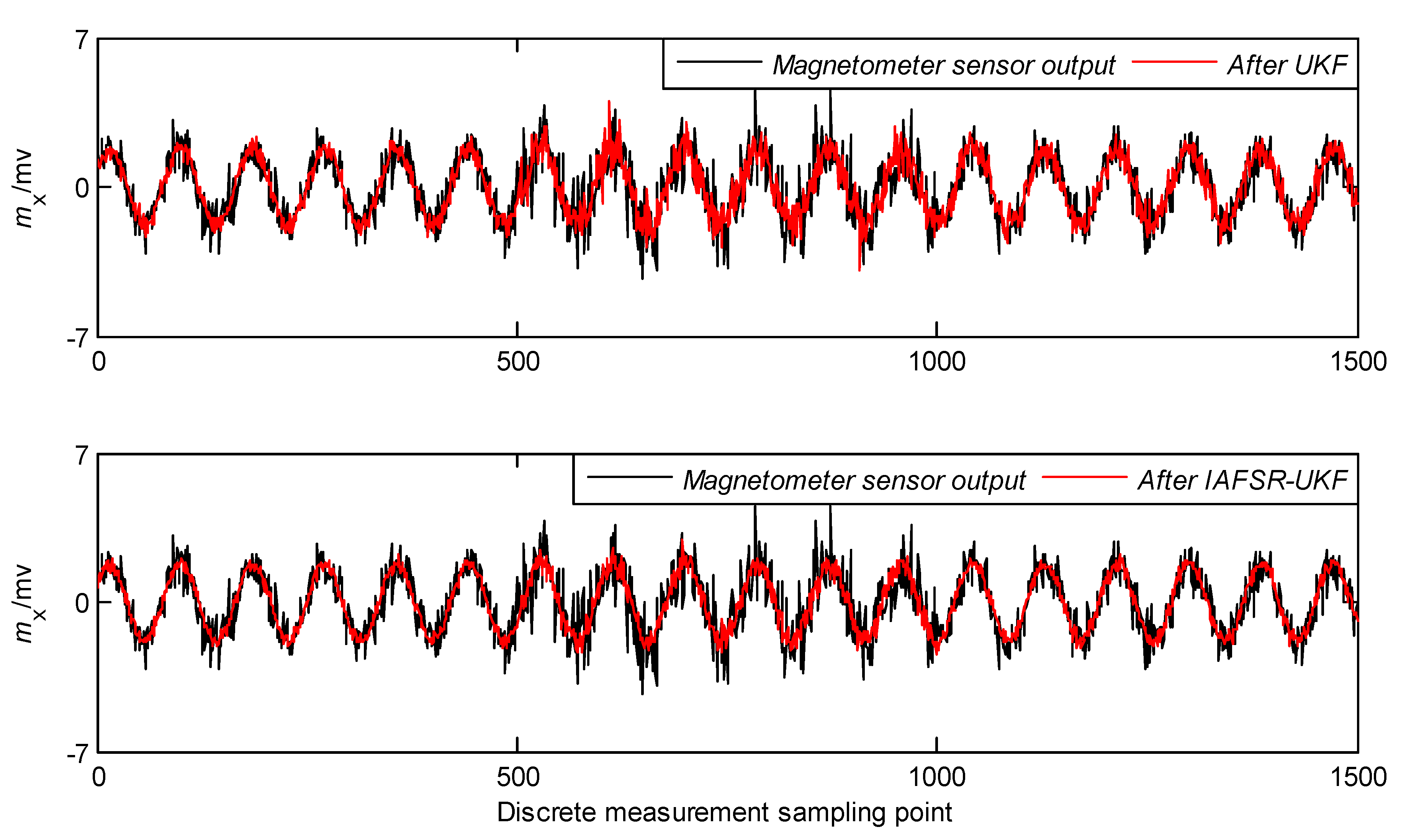

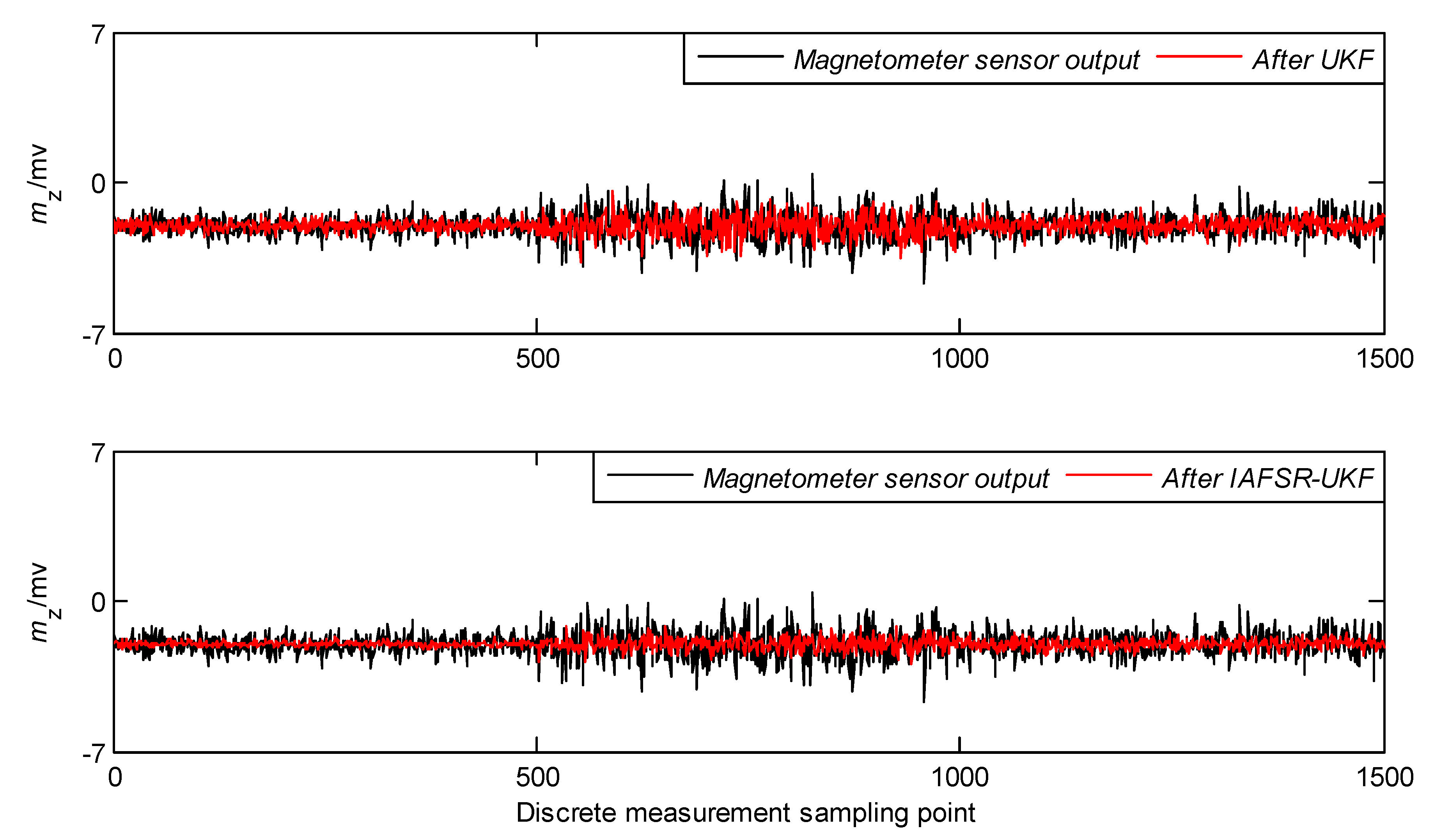


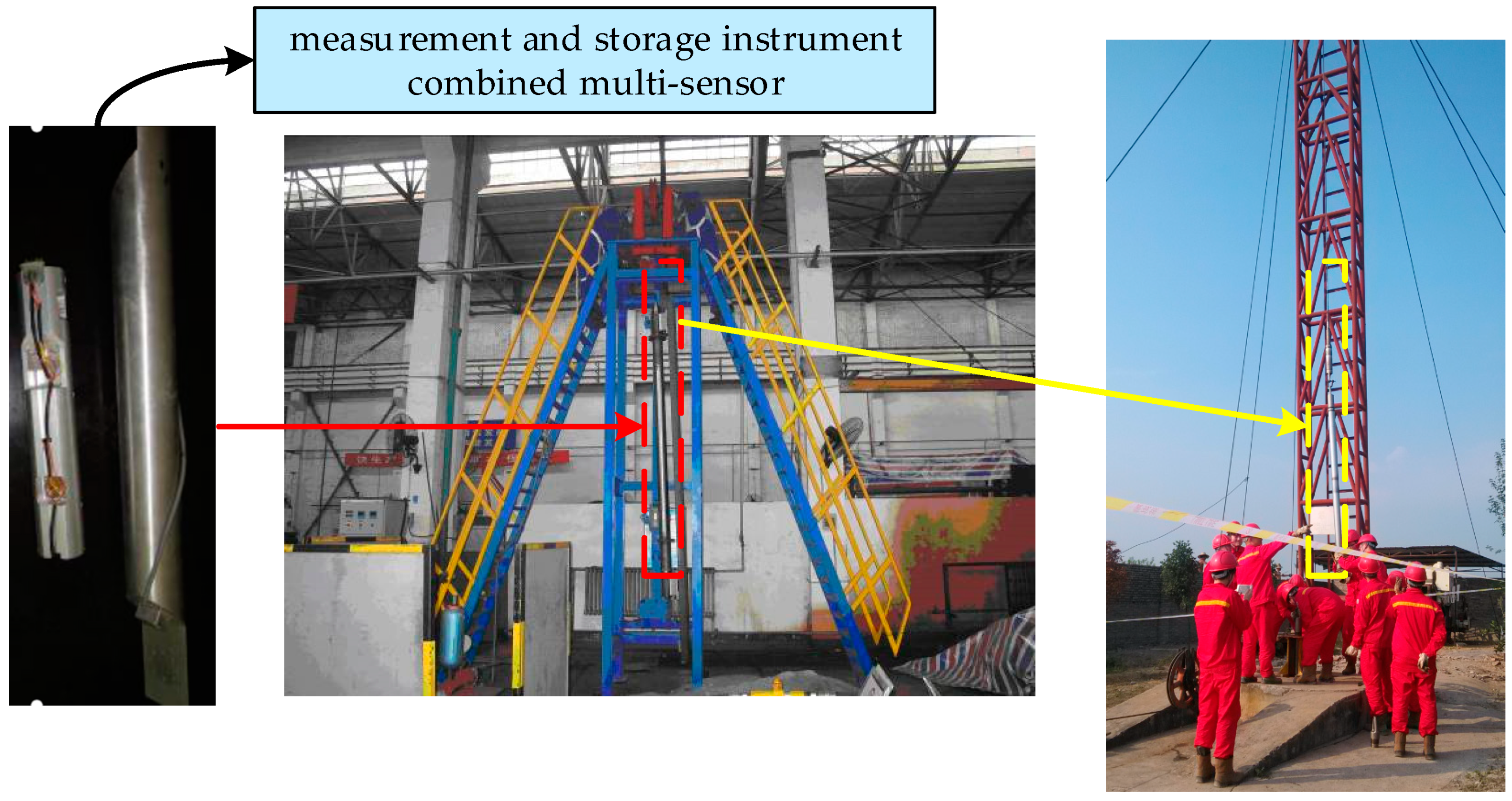

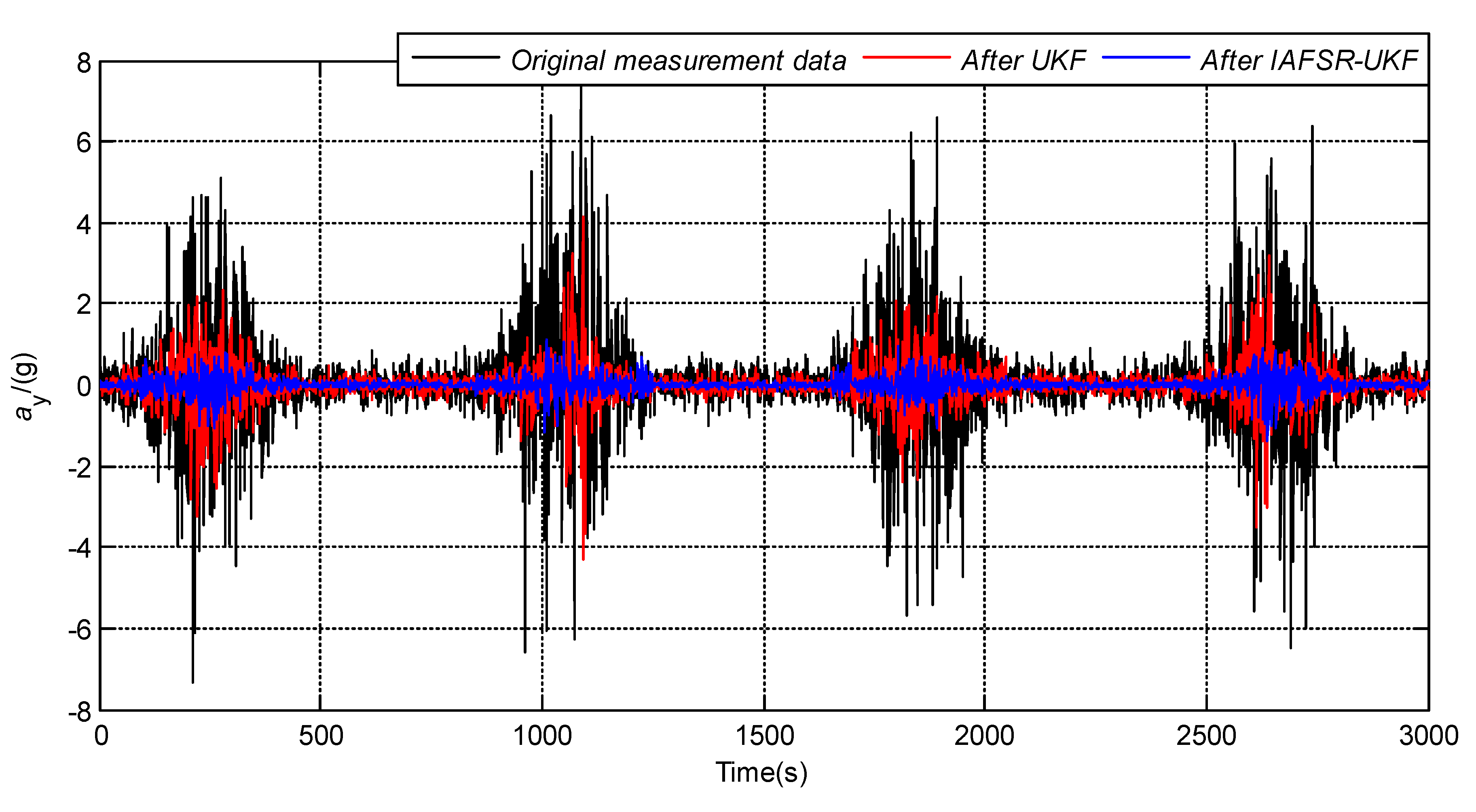
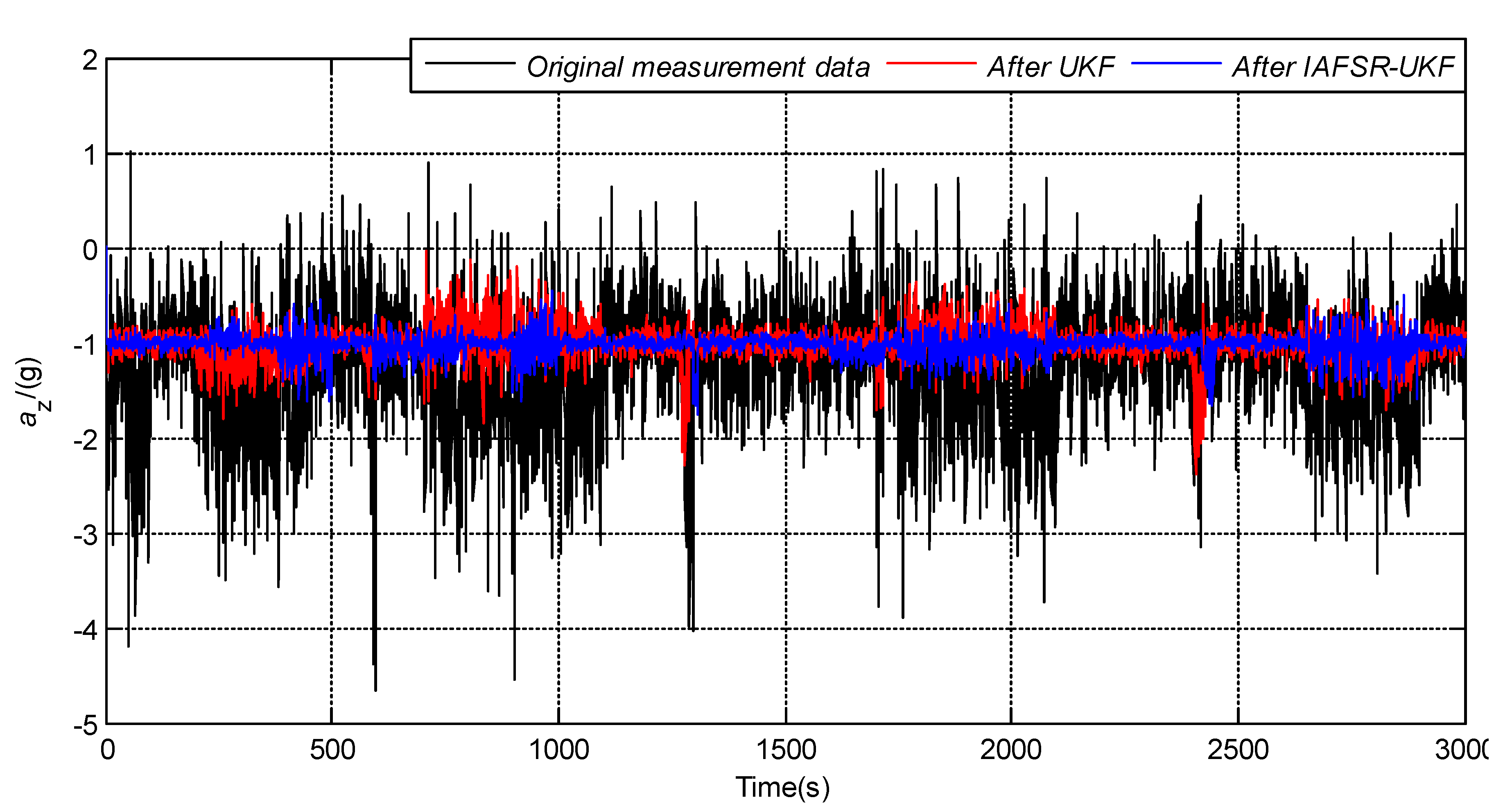

| Algorithm | Drilling Tool Attitude Angle | Statistics of Filtering Solution Error | |
|---|---|---|---|
| Max Error | RMS Error | ||
| IAFSR-UKF | inclination (°) | 1.42 | 0.46 |
| azimuth (°) | 8.78 | 2.18 | |
| Classical UKF | inclination (°) | 3.11 | 0.72 |
| azimuth (°) | 18.61 | 5.47 | |
| Without filtering | inclination (°) | 24.01 | 5.54 |
| azimuth (°) | 257.57 | 65.17 | |
| Parameter | Value |
|---|---|
| Well depth | 1740–1807 m |
| WOB | 10 MPa |
| Downhole temperature | 40 °C |
| Pump pressure | 6.6 MPa |
| Drilling fluid density | 1.15 g/cm3 |
| Suspended load | 79 kN |
| Operation time | 75 h |
| Rotary speed | 120 rpm |
| The setting value of inclination | 2.5° |
| Parameter | Accelerometer (CS-3LAS) | Magnetometer (HMC5983) |
|---|---|---|
| Range | ±10 g | ±100 μT |
| Scale factor | 200 mv/g | 5 V/G ± 5% |
| Non-linearity | 0.8% | - |
| Calibration | <50 mg | ±0.005 G |
| Noise | 0.14 mg/Hz1/2 | ≤0.2 nT |
| Bandwidth | 1000 Hz | 300 Hz |
| Algorithm | Attitude Parameters | Depth/m | ||||
|---|---|---|---|---|---|---|
| 1754.265 | 1765.36 | 1776.455 | 1787.55 | 1798.645 | ||
| Static measurement | Inclination (°) | 2.39 | 2.52 | 2.50 | 2.42 | 2.47 |
| Azimuth (°) | 200.8 | 205.5 | 215.2 | 202.4 | 211.8 | |
| UKF | Inclination (°) | 2.17 | 1.90 | 3.46 | 3.11 | 3.22 |
| Relative error | 9.2% | 24.6% | 38.4% | 28.5% | 30.4% | |
| Azimuth (°) | 181.0 | 211.1 | 201.4 | 189.5 | 223.5 | |
| Relative error | 9.86% | 2.73% | 6.41% | 6.37% | 5.52% | |
| MSTSR-UKF | Inclination (°) | 2.78 | 2.90 | 3.02 | 2.16 | 2.94 |
| Relative error | 16.3% | 15.1% | 20.8% | 10.7% | 19% | |
| Azimuth (°) | 204.3 | 209.8 | 203.7 | 208.3 | 204.5 | |
| Relative error | 1.74% | 2.09% | 5.34% | 2.92% | 3.45% | |
© 2020 by the authors. Licensee MDPI, Basel, Switzerland. This article is an open access article distributed under the terms and conditions of the Creative Commons Attribution (CC BY) license (http://creativecommons.org/licenses/by/4.0/).
Share and Cite
Yang, Y.; Li, F.; Gao, Y.; Mao, Y. Multi-Sensor Combined Measurement While Drilling Based on the Improved Adaptive Fading Square Root Unscented Kalman Filter. Sensors 2020, 20, 1897. https://doi.org/10.3390/s20071897
Yang Y, Li F, Gao Y, Mao Y. Multi-Sensor Combined Measurement While Drilling Based on the Improved Adaptive Fading Square Root Unscented Kalman Filter. Sensors. 2020; 20(7):1897. https://doi.org/10.3390/s20071897
Chicago/Turabian StyleYang, Yi, Fei Li, Yi Gao, and Yanhui Mao. 2020. "Multi-Sensor Combined Measurement While Drilling Based on the Improved Adaptive Fading Square Root Unscented Kalman Filter" Sensors 20, no. 7: 1897. https://doi.org/10.3390/s20071897
APA StyleYang, Y., Li, F., Gao, Y., & Mao, Y. (2020). Multi-Sensor Combined Measurement While Drilling Based on the Improved Adaptive Fading Square Root Unscented Kalman Filter. Sensors, 20(7), 1897. https://doi.org/10.3390/s20071897





